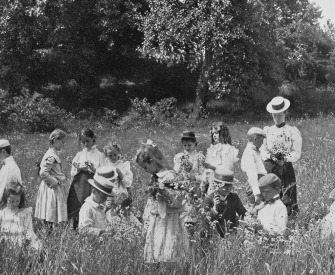When our guides first led us to the geyser, the basin was filled to within a few feet of its edge. The water was transparent as crystal; a slight steam only arose from it, and the surface was ruffled but by a few bubbles, which now and then came from the bottom of the pipe. We waited with anxiety for several minutes, expecting at every instant some interruption to this tranquility. On a sudden, another spring, immediately in front of the place on which we were standing, darted its waters above a hundred feet into the air with the velocity of an arrow, and the jets succeeding this first eruption were still higher.
While gazing in silence and wonder at this unexpected and beautiful display, we were alarmed by a sudden shock of the ground under our feet, accompanied with a hollow noise, not unlike the distant firing of cannon. Another shock soon followed, and we observed the water in the basin to be much agitated. The Icelanders hastily laid hold of us, and forced us to retreat some yards. The water in the meantime boiled violently and heaved as if some expansive power were laboring beneath its weight, and some of it was thrown up a few feet above the basin. Again there were two or three shocks of the ground and a repetition of the same noise. In an instant the surrounding atmosphere was filled with volumes of steam rolling over each other as they ascended, in a manner inexpressibly beautiful, and through which columns of water, shivering into foam, darted in rapid succession to heights which, at the time, we were little qualified to estimate. Indeed, the novelty and splendor of such a scene had affected our imaginations so forcibly that we believed the extreme height of the jet to be much greater than it was afterward determined to be. In a subsequent eruption, Mr. Baine ascertained, by means of a quadrant, the greatest elevation to which the jets of water were thrown to be ninety-six feet.
Much of the water began to descend again at different heights, and was again projected by other columns, which met it as they arose. At last, having filled the basin, it rolled in great waves over its edge and, forming numberless rills, made its way down the sides of the mound. Much was lost in vapor also, and still more fell to the ground in heavy showers of spray. The intervals at which the several jets succeeded each other were too short for the eye to distinguish them. As they rose out of the basin, they reflected, by their density, the purest and most brilliant blue. In certain shades, the color was green like that of the sea; but in their further ascent, all distinction of color was lost, and the jets, broken into a thousand parts, appeared white as snow. Several of them were forced upward perpendicularly; but many, receiving a slight inclination as they burst from the basin, were projected in beautiful curves, and the spray which fell from them, caught by a succeeding jet, was hurried away still higher than it had been perhaps before.
The jets were made with inconceivable velocity, and those which escaped uninterrupted terminated in sharp points and lost themselves in the air. The eruption, changing its form at every instant and blending variously with the clouds of steam that surrounded it, continued for ten or twelve minutes; the water then subsided through the pipe and disappeared.
I cannot flatter myself that the description I have attempted of their eruptions will impress you with a just idea of their beauty. Sources of comparison are wanting, by which the portraiture of such extraordinary scenes can be assisted. Nature nowhere offers objects bearing a resemblance to them; and art, even in constructing the waterworks of Versailles, has produced nothing that can at all illustrate the magnificent appearances of the geyser. All then that I hope for is to have said so much as may enable you to complete in your imagination the picture which I have only sketched.
From “An Account of the Hot Springs near Haukadal in Iceland.” The idea to travel to Iceland was suggested by a friend of Stanley’s in 1788 while the young lord was studying at Edinburgh University. “ ‘When we go to Iceland’ became at last a proverb to us,” Stanley wrote in his journals, “and we talked of the geysers.” Diaries of the trip reveal, according to a scholar, “an intriguing glimpse of that ‘gothick’ infatuation, armchair primitivism, and emerging Icelandophilia which gripped many an educated British consciousness at the end of the eighteenth century.”
Back to Issue



